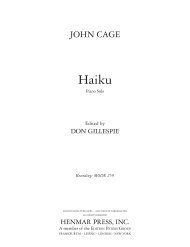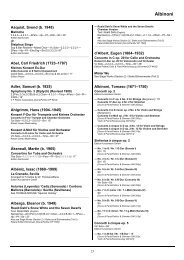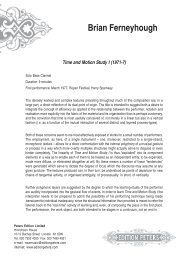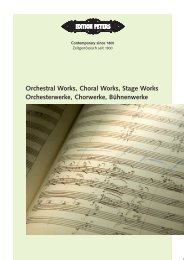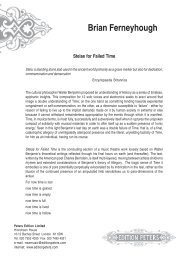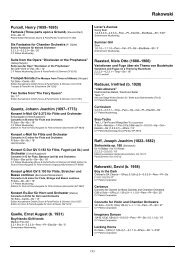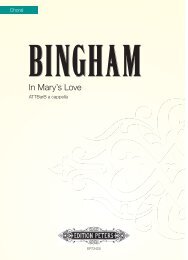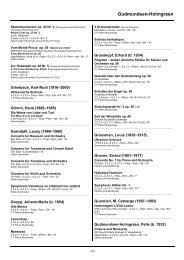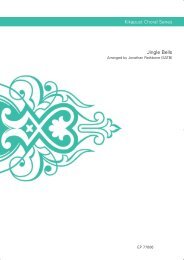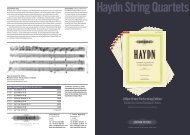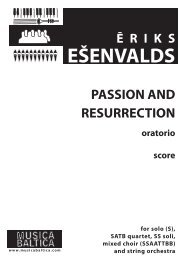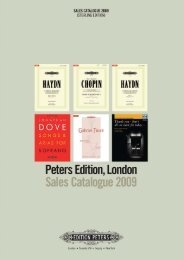Chopin at 200 - SBC Talks Booklet - Edition Peters
Chopin at 200 - SBC Talks Booklet - Edition Peters
Chopin at 200 - SBC Talks Booklet - Edition Peters
Create successful ePaper yourself
Turn your PDF publications into a flip-book with our unique Google optimized e-Paper software.
CHOPIN AT <strong>200</strong><br />
AT SOUTHBANK CENTRE<br />
As part of the Intern<strong>at</strong>ional Piano Series <strong>200</strong>9/10,<br />
join the celebr<strong>at</strong>ions of the bicentenary of the birth<br />
of <strong>Chopin</strong> with the following concerts:<br />
MONDAY 23 NOVEMBER <strong>200</strong>9<br />
LOUIS LORTIE<br />
TUESDAY 19 JANUARY 2010<br />
CÉDRIC TIBERGHIEN<br />
SATURDAY 6 FEBRUARY 2010<br />
CHOPIN FORUM<br />
A discussion of the man and his<br />
music by leading <strong>Chopin</strong> scholars<br />
Monday 22 February 2010<br />
KRYSTIAN ZIMERMAN<br />
<strong>Chopin</strong> Birthday Concert 1<br />
S<strong>at</strong>urday 27 February 2010<br />
CHOPIN MASTERCLASS<br />
PETER DONOHOE<br />
Six pre-concert talks in the<br />
Intern<strong>at</strong>ional Piano Series <strong>200</strong>9/10<br />
by some of the world’s leading<br />
experts on <strong>Chopin</strong> and Polish music<br />
CHOPIN<br />
CELEBRATING A MUSICAL IMAGINATION<br />
<strong>Talks</strong> booklet<br />
Monday 1 March 2010<br />
MAURIZIO POLLINI<br />
<strong>Chopin</strong> Birthday Concert 2<br />
Thursday 25 March 2010<br />
YEVGENY SUDBIN<br />
Wednesday 14 April 2010<br />
NIKOLAI DEMIDENKO<br />
Thursday 29 April 2010<br />
PASCAL ROGÉ<br />
Tickets 0844 847 9910<br />
www.southbankcentre.co.uk
Six pre-concert talks on the theme <strong>Chopin</strong> <strong>at</strong> <strong>200</strong>: Celebr<strong>at</strong>ing<br />
a Musical Imagin<strong>at</strong>ion accompany the <strong>Chopin</strong> recitals in the<br />
Intern<strong>at</strong>ional Piano Series <strong>200</strong>9/10. Convened by John Rink<br />
and presented by leading intern<strong>at</strong>ional experts on <strong>Chopin</strong> and<br />
Polish music, the talks focus on <strong>Chopin</strong>’s musical innov<strong>at</strong>ions<br />
as well as his cre<strong>at</strong>ive use of past traditions.<br />
Programme<br />
23 November <strong>200</strong>9 Revolutionary Studies David Rowland<br />
19 January 2010 Echoes of Poland Adrian Thomas<br />
22 February 2010 The Classical Romantic John Rink<br />
25 March 2010 The Spirit of Improvis<strong>at</strong>ion Jim Samson<br />
14 April 2010 Virtuosity Redefined John Rink<br />
29 April 2010 Music in Sound Roy How<strong>at</strong><br />
Speakers<br />
Pianist Roy How<strong>at</strong> is author of the recently<br />
published book The Art of French Piano Music<br />
(Yale University Press). He has also edited<br />
Urtext volumes of Debussy and Fauré piano<br />
and chamber music, much of which he has<br />
recorded on CD. He is Keyboard Research<br />
Fellow <strong>at</strong> the Royal Academy of Music.<br />
John Rink is Professor of Musical<br />
Performance Studies <strong>at</strong> the University of<br />
Cambridge. Author of a Cambridge Music<br />
Handbook on <strong>Chopin</strong>’s concertos, he directs<br />
<strong>Chopin</strong>’s First <strong>Edition</strong>s Online<br />
(www.cfeo.org.uk) and the Online <strong>Chopin</strong><br />
Variorum <strong>Edition</strong> (www.ocve.org.uk). He is a<br />
noted performer on period pianos.<br />
David Rowland is Professor of Music and<br />
Dean of Arts <strong>at</strong> the Open University, and<br />
Director of Music <strong>at</strong> Christ’s College<br />
Cambridge. He has written extensively on<br />
the performance history of the early piano,<br />
and his books include A History of<br />
Pianoforte Pedalling, The Cambridge<br />
Companion to the Piano and Early Keyboard<br />
Instruments: A Practical Guide.<br />
Jim Samson is Professor of Music <strong>at</strong> Royal<br />
Holloway, University of London. He has<br />
published extensively on the music of<br />
<strong>Chopin</strong> and other topics, and in 1989 was<br />
awarded the Order of Merit from the Polish<br />
Ministry of Culture. Along with John Rink<br />
and Jean-Jacques Eigeldinger, he is a<br />
Series Editor of The Complete <strong>Chopin</strong> –<br />
A New Critical <strong>Edition</strong>, published by<br />
<strong>Peters</strong> <strong>Edition</strong>.<br />
Adrian Thomas is Professor of Music <strong>at</strong><br />
Cardiff University. He has broadcast and<br />
published widely on Polish music, including<br />
monographs on Bacewicz (1985), Górecki<br />
(1997) and Lutosławski’s Cello Concerto<br />
(forthcoming). He is the author of Polish<br />
Music since Szymanowski (<strong>200</strong>5).<br />
<strong>Chopin</strong> <strong>at</strong> <strong>200</strong>
David Rowland<br />
<strong>Chopin</strong> <strong>at</strong><strong>200</strong><br />
23 November <strong>200</strong>9<br />
Revolutionary Studies<br />
David Rowland<br />
Theme<br />
The early nineteenth century saw a huge<br />
increase of study liter<strong>at</strong>ure for the piano in<br />
which the etude occupied a central place.<br />
This lecture charts the history of the genre<br />
and assesses <strong>Chopin</strong>’s unique position<br />
within it.<br />
Quot<strong>at</strong>ions<br />
I told him [Erard, in 1801] I had long<br />
medit<strong>at</strong>ed on a collection of exercises to<br />
form a complete pianoforte performer to<br />
which I should give the title ‘Studio’, and<br />
which we should publish <strong>at</strong> the same<br />
time. Now, as Cramer and he were very<br />
intim<strong>at</strong>e, he divulged the secret to him;<br />
and as I went out of England the year<br />
after, Cramer took advantage of my<br />
absence to be beforehand with me, and<br />
published his ‘Studio’. (Clementi to the<br />
publisher Härtel, 1818)<br />
[On playing five-finger exercises] I soon<br />
resolved to try to read <strong>at</strong> the same time<br />
th<strong>at</strong> I gave my fingers their daily work…<br />
since then, I have always read during<br />
practice. (Kalkbrenner, [1831] 1858)<br />
He feared above all … the abrutissement<br />
[stupefaction by overwork] of the pupils.<br />
One day he heard me say th<strong>at</strong> I practised<br />
six hours a day. He became quite angry,<br />
and forbade me to practise more than<br />
three hours. (<strong>Chopin</strong>’s pupil Dubois,<br />
reported in Niecks, [1888] 1902)<br />
He never tired of inculc<strong>at</strong>ing th<strong>at</strong> the<br />
appropri<strong>at</strong>e exercises are not merely<br />
mechanical but claim the intelligence and<br />
entire will of the pupil, so th<strong>at</strong> a<br />
twentyfold or fortyfold repetition (even<br />
nowadays the worshipped Arcanum of so<br />
many schools) does no good <strong>at</strong> all.<br />
(<strong>Chopin</strong>’s pupil Mikuli, [1880])<br />
I write unaware of wh<strong>at</strong> my pen is<br />
scribbling since <strong>at</strong> this very moment Liszt<br />
is playing my [Op. 10] Etudes, transferring<br />
me beyond the range of sensible thoughts.<br />
I would like to steal from him the manner<br />
of performing my own compositions. (Liszt,<br />
<strong>Chopin</strong> and Franchomme to Hiller, 1833)<br />
[<strong>Chopin</strong>] bade me practise it [Op. 10 No.<br />
1] in the mornings very slowly. ‘This etude<br />
will do you good’, he said, ‘if you study it<br />
as I intended it, it widens the hand and<br />
enables you to play runs of wide broken<br />
chords, like bow strokes. But often,<br />
unfortun<strong>at</strong>ely, instead of making people<br />
learn all th<strong>at</strong>, it makes people unlearn it’.<br />
I am quite aware th<strong>at</strong> it is a generally<br />
prevalent error, even in our day, th<strong>at</strong> one<br />
can only play this study well when one<br />
possesses a very large hand. But th<strong>at</strong> is<br />
not the case, only a supple hand is<br />
required. (<strong>Chopin</strong>’s pupil Müller-Streicher,<br />
reported in Niecks, [1888] 1902)<br />
Did [Clara] Wieck play my Etude [Op. 10<br />
No. 5] well How could she have chosen<br />
precisely this Etude, the least interesting<br />
for those who do not know th<strong>at</strong> it is<br />
intended for the black keys, instead of<br />
something better! (<strong>Chopin</strong> to Fontana,<br />
1839)<br />
[Op. 25 No. 1] It would be a mistake,<br />
however, to suppose th<strong>at</strong> he played in<br />
such a way th<strong>at</strong> you could hear every note.<br />
It was r<strong>at</strong>her an undul<strong>at</strong>ion of the A-fl<strong>at</strong><br />
major chord, propelled aloft every now and<br />
again from the pedal. … Afterwards one<br />
felt as though one had just seen a<br />
beautiful image in a dream. (Schumann,<br />
[1837] 1965)<br />
[Op. 25] The etudes are all symbols of his<br />
bold, inherent cre<strong>at</strong>ive strength – true<br />
poetic images. (Schumann, [1837] 1965)<br />
Texts<br />
You must appeal to the pupil’s intelligence<br />
and reason, lead him to work more with<br />
the mind than with the fingers, to think<br />
and concentr<strong>at</strong>e more. He must clearly<br />
understand th<strong>at</strong> the important thing is not<br />
the quantity by the quality of his work, and<br />
th<strong>at</strong> purely mechanical work, with no<br />
thought, is useless. Above all you must<br />
show him how to work so as to achieve the<br />
best results in the shortest time and so<br />
th<strong>at</strong> his virtuosity may equally become a<br />
means of expression. (Philipp, 1927, 6;<br />
trans. from Eigeldinger, 1986, 98)<br />
Developments in didactic keyboard music<br />
engendered three varieties of composition<br />
which may be classified briefly as follows:<br />
(i) exercises, in which a didactic objective<br />
– the isol<strong>at</strong>ion and repetition of a specific<br />
technical formula – is assigned primary<br />
<strong>at</strong>tention, any musical or characteristic<br />
interest being incidental; (ii) etudes,<br />
wherein musical and didactic functions<br />
properly stand in a complementary and<br />
indivisible associ<strong>at</strong>ion; and (iii) concert<br />
studies, in which the didactic element is<br />
mostly incidental to the primary<br />
characteristic substance (though the<br />
music will invariably involve some<br />
particular exploit<strong>at</strong>ion and demonstr<strong>at</strong>ion<br />
of virtuoso technique). (Finlow, 1992, 53).<br />
In all of them [<strong>Chopin</strong>’s Etudes] <strong>Chopin</strong><br />
addressed himself system<strong>at</strong>ically to the<br />
world of pianistic technique which had<br />
spawned the virtuoso style. But the result<br />
rises far above the dry exercises of a<br />
Czerny or the flashy acrob<strong>at</strong>ics of a<br />
Thalberg. To a degree barely approached<br />
in earlier piano studies he gave substance<br />
and poetry to the genre, conquering<br />
virtuosity on its home ground, and in<br />
doing so lifting himself clear of the<br />
surrounding lowland of mediocrity.<br />
(Samson, 1985, 59).<br />
References<br />
Clementi, Muzio, 1801. Introduction to the Art of<br />
Playing on the Piano forte (London: Clementi & Co.;<br />
reprinted in an edition by Sandra Rosenblum: New<br />
York: Da Capo Press, 1974).<br />
Clementi, Muzio, 1817–26. Gradus ad parnassum,<br />
volumes 1–3 (London: Clementi & Co.; republished<br />
in many subsequent editions).<br />
Cramer, Johann Baptist, 1804–08. Studio per il<br />
pianoforte, books 1 and 2 (London: the author;<br />
republished in many subsequent editions).<br />
Eigeldinger, Jean-Jacques, 1986. <strong>Chopin</strong>: Pianist and<br />
Teacher as seen by his Pupils, trans. Naomi Shohet<br />
with Krysia Osostowicz and Roy How<strong>at</strong>, ed. Roy<br />
How<strong>at</strong> (Cambridge: Cambridge University Press).<br />
Finlow, Simon, 1992. ‘The twenty-seven etudes and<br />
their antecedents’, in Jim Samson (ed.), The<br />
Cambridge Companion to <strong>Chopin</strong> (Cambridge:<br />
Cambridge University Press), pp. 50–77.<br />
Kalkbrenner, Frédéric, 1831. Méthode pour apprendre<br />
le Piano à l’aide du Guide-Mains, Op. 108 (Paris:<br />
Pleyel). Trans. Sabilla Novello as Method of Learning<br />
the Pianoforte (London: Novello, 1858).<br />
Mikuli, Carl, [1880]. Foreword to Fr. <strong>Chopin</strong>’s<br />
Pianoforte-Werke (Leipzig: Kistner). Transl<strong>at</strong>ion from<br />
Eigeldinger, 1986.<br />
Niecks, Frederick, [1888] 1902. Frederick <strong>Chopin</strong> as<br />
a Man and Musician, 3rd edn (London: Novello).<br />
Philipp, Isidore, 1927: Quelques considér<strong>at</strong>ions sur<br />
l'enseignement du piano (Paris: A. Durand et fils).<br />
Pleasants, Henry, 1965. The Musical World of Robert<br />
Schumann (London: Gollancz).<br />
Samson, Jim, 1985. The Music of <strong>Chopin</strong> (London:<br />
Routledge and Kegan Paul).<br />
<strong>Chopin</strong> <strong>at</strong> <strong>200</strong>
Adrian Thomas<br />
<strong>Chopin</strong> <strong>at</strong><strong>200</strong><br />
19 January 2010<br />
Echoes of Poland<br />
Adrian Thomas<br />
Theme<br />
The mazurka and polonaise have come to<br />
symbolise Polishness not only in Poland but<br />
abroad, whether written by exiled Poles or<br />
foreign composers. This talk looks in<br />
parti-cular<strong>at</strong>thecharacterandloc<strong>at</strong>ionof<br />
mazurkas in nineteenth- and twentiethcentury<br />
music.<br />
Quot<strong>at</strong>ions<br />
The land which gave him life with its song<br />
affected his musical disposition. … many a<br />
note of his music sounds like a happy<br />
reflection of our n<strong>at</strong>ive harmony. In his hands<br />
the simple mazur willingly yields to<br />
alter<strong>at</strong>ions and modul<strong>at</strong>ions yet preserves its<br />
own accent and expression. In order, as<br />
<strong>Chopin</strong> did, to include the beautiful simplicity<br />
of n<strong>at</strong>ive song in his refined compositions<br />
of genius he had to feel and to<br />
recognise the echoes of our fields and forests,<br />
to hear the song of our Polish villages.<br />
(Wojciech Grzymała, Kurier Polski, 18 March<br />
1830; cited in Samson, 1992, 209)<br />
Here, waltzes are called works! … I don’t<br />
pick up anything th<strong>at</strong> is essentially Viennese.<br />
I don’t even know how to dance a waltz<br />
properly. … My piano has heard only mazury.<br />
(Fryderyk <strong>Chopin</strong>, letters, Vienna, 1831; cited<br />
in Samson, 1992, 153)<br />
From time to time you hear through the<br />
window opening onto the garden strains of<br />
<strong>Chopin</strong>’s music, blending with the<br />
nightingales and the scent of the roses.<br />
(Eugène Delacroix, letter, 1842; cited in<br />
Samson, 1996, 199)<br />
I spent three months in London and was in<br />
fairly good health. I gave two m<strong>at</strong>inéeconcerts,<br />
one <strong>at</strong> Mrs. Sartori’s and the other<br />
<strong>at</strong> Lord Falmouth’s – both with gre<strong>at</strong> success<br />
… At the second Mme Viardot sang three<br />
groups [including some mazurkas] and I<br />
played four [including the Scherzo Op. 31,<br />
mazurkas and a ballade]. They liked th<strong>at</strong> very<br />
much, for they had never heard such short<br />
and compact concerts here. They are only<br />
used to long affairs with twenty different<br />
items ... (<strong>Chopin</strong>, letter to Warsaw from<br />
Edinburgh, 10–19 August 1848; in Hedley,<br />
1962, 331)<br />
Polish n<strong>at</strong>ional music is not the coagul<strong>at</strong>ed<br />
spectre of a polonaise or mazurka ... r<strong>at</strong>her<br />
the solitary, happy, carefree song of a nightingale<br />
in the middle of a fragrant Polish May<br />
night. (Karol Szymanowski, ‘On Contemporary<br />
Musical Opinion in Poland’, 1920)<br />
Texts<br />
The traditional folk ensemble of central<br />
Poland consisted of a melody instrument (the<br />
violin played in first position on the upper<br />
strings, or the fujarka, a high-pitched<br />
shepherd’s pipe) plus an instrument or two to<br />
provide a drone (lower open strings on the<br />
violin, or the dudy or gajdy, a Polish bagpipe),<br />
and/or a rhythmic pulse (the basetla or basy,<br />
a string bass played unstopped). (Thomas,<br />
1992, 154)<br />
For many years [Szymanowski] had felt th<strong>at</strong><br />
to write piano mazurkas which were not<br />
simply cheap imit<strong>at</strong>ions of <strong>Chopin</strong>’s<br />
masterpieces would be impossible. … The<br />
most important new ingredient was of course<br />
the Góral music of the T<strong>at</strong>ras, bringing to the<br />
mazurka a bre<strong>at</strong>h of sharp, bracing mountain<br />
air and transforming the <strong>Chopin</strong> form whose<br />
folkloristic inspir<strong>at</strong>ion lay essentially in the<br />
plains of the central Mazovia region of<br />
Poland. (Samson, 1981, 169)<br />
Poetic texts (in free verse)<br />
Włodzimierz Wolski, ‘Fryderyk <strong>Chopin</strong>. Fantasia’ (excerpt, 1859)<br />
The garland starts with mazurkas, Her girlfriends invite her to the dance,<br />
Apparently coquettish,<br />
And though there’s the will to dance,<br />
Fine, light and strange,<br />
The girl’s face inclines sadly,<br />
And so sad, and so sad …<br />
For how is it possible for an orphan to dance<br />
Like the girl who continues to expect Suddenly someone’s arriving on a dun …<br />
Her brother from the war, The girl runs, claps her hands –<br />
And with tears plaits her hair,<br />
A stranger is leading the horse,<br />
And with tears sings her songs –<br />
For her brother has died in the war,<br />
Sad, sad are these mazurkas!<br />
Cyprian Kamil Norwid, ‘<strong>Chopin</strong>’s Piano’, iv (1865)<br />
And in wh<strong>at</strong> the note played – and said – and will say,<br />
Although the echoes will differently be arrayed<br />
Than when you yourself blessed with your Own hand each chord –<br />
And in wh<strong>at</strong> the note played, such was the simplicity of Periclean perfection,<br />
As if some Virtue from antiquity, stepping into a rustic wooden dwelling,<br />
Said to herself: I have been reborn in heaven;<br />
And the doorway has become my harp, the footp<strong>at</strong>h my ribbon …<br />
Kazimierz Tetmajer, ‘<strong>Chopin</strong>’s Mazurek’ (1910)<br />
A young lady, a young lady<br />
I have a perfect method:<br />
Combs her golden hair,<br />
I shall smile first,<br />
She sings to herself: whoever I want Then I will give a kiss, and then<br />
I shall lead by the nose!<br />
Wh<strong>at</strong> the lake-nymph does to the lad.<br />
And so on, and so on …<br />
Who can resist me<br />
It’s true – they called me bad names,<br />
But was I the only one …<br />
Leopold Staff, ‘Townie’ (1937) ‘In jest. Nonsense’ (1949)<br />
I don’t like peasant music,<br />
Never with a more enchanting song<br />
With its boisterous refrain.<br />
Was Odysseus lured by the Siren:<br />
Its wild rhythm terrifies me:<br />
If violets and lilies of the valley<br />
I am afraid of becoming <strong>Chopin</strong>.<br />
Instead of being fragrant knew how to play,<br />
It would be the music of <strong>Chopin</strong>.<br />
References<br />
Hedley, Arthur (ed.), 1962. Selected Correspondence<br />
of Fryderyk <strong>Chopin</strong> (London: Heinemann).<br />
Samson, Jim, 1981. The Music of Szymanowski<br />
(London: Kahn & Averill).<br />
Samson, Jim (ed.), 1992. The Cambridge Companion<br />
to <strong>Chopin</strong> (Cambridge: Cambridge University Press).<br />
Samson, Jim, 1996. Master Musicians <strong>Chopin</strong><br />
(Oxford: Oxford University Press).<br />
Thomas, Adrian, 1992. ‘Beyond the dance’, in<br />
Samson 1992, pp. 145–59.<br />
Wightman, Alistair, 1999a. Karol Szymanowski. His<br />
Life and Work (Aldershot: Ashg<strong>at</strong>e).<br />
Wightman, Alistair (ed.), 1999b. Szymanowski on<br />
Music. Selected Writings (London: Tocc<strong>at</strong>a Press).<br />
<strong>Chopin</strong> <strong>at</strong><strong>200</strong>
John Rink<br />
<strong>Chopin</strong> <strong>at</strong><strong>200</strong><br />
22 February 2010<br />
The Classical Romantic<br />
John Rink<br />
Theme<br />
This talk explores some of the issues<br />
surrounding two of <strong>Chopin</strong>’s most<br />
significant works, the Son<strong>at</strong>as in B-fl<strong>at</strong><br />
minor Op. 35 and B minor Op. 58. The<br />
expressive depth and breadth of these<br />
masterpieces are described with reference<br />
to diverse elements within <strong>Chopin</strong>’s<br />
musical language.<br />
Quot<strong>at</strong>ions and other texts<br />
[Op. 35] Anyone glancing <strong>at</strong> the first bars<br />
of this son<strong>at</strong>a and uncertain of its author<br />
would not prove himself a good<br />
connoisseur. Only <strong>Chopin</strong> begins and ends<br />
in this way: with dissonances through<br />
dissonances into dissonances. But how<br />
many beauties, too, does this piece<br />
contain! The idea of calling it a son<strong>at</strong>a is<br />
a caprice, if not a jest, for he has simply<br />
bound together four of his most reckless<br />
children; thus under his name smuggling<br />
them into a place into which they could<br />
not else have penetr<strong>at</strong>ed… (Schumann,<br />
[1841] 1946, 140)<br />
[Op. 35] This son<strong>at</strong>a … has five fl<strong>at</strong>s for<br />
[a key] sign<strong>at</strong>ure and is in B-fl<strong>at</strong> minor, a<br />
key th<strong>at</strong> certainly cannot boast of special<br />
popularity. … [Its] thoroughly<br />
<strong>Chopin</strong>esque beginning is followed by one<br />
of those stormy, passion<strong>at</strong>e movements<br />
with which <strong>Chopin</strong> al ready has acquainted<br />
us. This must be heard often and well<br />
performed. But even the first part of the<br />
work brings us a beautiful cantilena;<br />
indeed, it seems as if the n<strong>at</strong>ional Polish<br />
flavour, which clung to most of <strong>Chopin</strong>’s<br />
earlier melodies, were dwindling, and th<strong>at</strong><br />
he now sometimes leans toward Italy via<br />
Germany. … [Yet] the whole movement<br />
ends in a manner by no means Italian;<br />
and this reminds me of a remark once<br />
made by Liszt: ‘Rossini and Co. always<br />
close with “I remain your very humble<br />
servant.”’ But it is otherwise with <strong>Chopin</strong><br />
whose endings express just the reverse.<br />
The second movement is merely the<br />
continu<strong>at</strong>ion of this mood; it is bold,<br />
spirited, fantastic; the trio tender, dreamy,<br />
entirely in <strong>Chopin</strong>’s manner; like many of<br />
Beethoven’s, it is a scherzo only in name.<br />
There follows a still more gloomy Marcia<br />
funebre which is re pellent; in its place an<br />
adagio, perhaps in D-fl<strong>at</strong>, would cer tainly<br />
have been more effective. Th<strong>at</strong> which in<br />
the last move ment is given to us under the<br />
name ‘finale’ resembles mockery more<br />
than any kind of music. Yet we must<br />
confess th<strong>at</strong> even from this joyless,<br />
unmelodious movement an original and<br />
terri fying spirit bre<strong>at</strong>hes on us which<br />
holds down with mailed fist everything<br />
th<strong>at</strong> seeks to resist, so th<strong>at</strong> we listen<br />
fascin<strong>at</strong>ed and uncomplaining to the end<br />
– though not to praise; for this is not<br />
music. Thus the son<strong>at</strong>a closes as it began,<br />
emph<strong>at</strong>ically, like a Sphinx with an ironic<br />
smile. (Schumann, [1841] 1946, 141–42)<br />
Among the works she studied with him,<br />
Mme [Marie] Roubaud cited … the Son<strong>at</strong>a<br />
in B minor, whose Largo, when he once<br />
played it to her, had his pupil in tears.<br />
(Ganche, 1925, cited in Eigeldinger, 1986,<br />
61)<br />
The eighteenth-century conception of<br />
recapitul<strong>at</strong>ion as resolution sometimes<br />
disappears. The second theme of <strong>Chopin</strong>’s<br />
Concerto No. 2 in F minor, first movement,<br />
is never played in the tonic <strong>at</strong> all, while<br />
the second group of <strong>Chopin</strong>’s Concerto No.<br />
1 in E minor is played in the exposition in<br />
the tonic major (!), and recapitul<strong>at</strong>ed in<br />
the mediant. <strong>Chopin</strong>’s key rel<strong>at</strong>ions in<br />
son<strong>at</strong>a form, however, were more orthodox<br />
after he left Poland. (The exposition of the<br />
Son<strong>at</strong>a in C minor, Op. 4, of 1827 never<br />
leaves the tonic. <strong>Chopin</strong> was only sixteen<br />
when he wrote it, but it is not the kind of<br />
mistake th<strong>at</strong> Mozart would have made<br />
when he was six. They evidently did not<br />
have very clear ideas about son<strong>at</strong>as out<br />
there in Warsaw.) (Rosen, 1980, 319)<br />
In almost every edition (and consequently<br />
most performances) of <strong>Chopin</strong>’s Son<strong>at</strong>a in<br />
B-fl<strong>at</strong> major, Op. 35, there is a serious<br />
error th<strong>at</strong> makes awkward nonsense of an<br />
important moment in the first movement.<br />
The repe<strong>at</strong> of the exposition begins in the<br />
wrong place. A double bar meant to<br />
indic<strong>at</strong>e the beginning of a new and faster<br />
tempo in measure 5 is generally decor<strong>at</strong>ed<br />
on both staves with the two dots th<strong>at</strong><br />
indic<strong>at</strong>e the opening of a section to be<br />
played twice. … [This] mistake was made<br />
in one of the early editions. … The faulty<br />
indic<strong>at</strong>ion is musically impossible: it<br />
interrupts a triumphant cadence in D-fl<strong>at</strong><br />
major with an accompanimental figure in<br />
B-fl<strong>at</strong> minor, a harmonic effect which is<br />
not even piquant enough to be interesting,<br />
and merely sounds perfunctory. The repe<strong>at</strong><br />
is clearly intended to begin with the first<br />
note of the movement: the opening four<br />
bars are not a slow introduction but an<br />
integral part of the exposition. (Rosen,<br />
1980, 279–80)<br />
… Hummel’s Son<strong>at</strong>a for Piano in F-sharp<br />
minor is … the easily recognisable model<br />
for <strong>Chopin</strong>’s Third Son<strong>at</strong>a in B minor.<br />
<strong>Chopin</strong>’s music is largely derived from his<br />
early experience of opera, the rhythms and<br />
harmonies of n<strong>at</strong>ive Polish dances, and<br />
Bach. The art th<strong>at</strong> held all this together<br />
came above all from the last, in particular<br />
the Well-Tempered Keyboard. If he ever<br />
knew the religious music of Bach, it was<br />
<strong>at</strong> a moment too l<strong>at</strong>e to be<br />
of any use to him. In order to disabuse<br />
ourselves of the impossible image of<br />
<strong>Chopin</strong> as an imagin<strong>at</strong>ive genius seriously<br />
limited by a deficient technique, it is with<br />
the craft th<strong>at</strong> we must start, not the<br />
genius, even if, in the end, it is the<br />
genius th<strong>at</strong> we hope to illumin<strong>at</strong>e.<br />
(Rosen, 1995, 285)<br />
[Regarding the ‘richness of invention of<br />
virtuoso figur<strong>at</strong>ion’ in <strong>Chopin</strong>’s ‘l<strong>at</strong>est<br />
works’]: In the scherzo of the Son<strong>at</strong>a in B<br />
minor, Op. 58, the counterpoint is partly<br />
built into the figur<strong>at</strong>ion. The<br />
accompaniment is almost minimal<br />
(although not completely devoid of motivic<br />
interest) because of the complexity of the<br />
figur<strong>at</strong>ion, which realises much of the<br />
harmony through an implied polyphonic<br />
structure of three voices. The art is clearly<br />
rel<strong>at</strong>ed to the monophonic technique of the<br />
finale of the Son<strong>at</strong>a in B-fl<strong>at</strong> minor, but<br />
here it sweeps through all the registers of<br />
the piano. (Rosen, 1995, 391)<br />
It seems important to grasp the unique<br />
shape of this son<strong>at</strong>a [Op. 35] before any<br />
consider<strong>at</strong>ions of them<strong>at</strong>ic unity are<br />
broached, particularly as it differs<br />
importantly from the historical archetype.<br />
Inevitably <strong>Chopin</strong>’s model results in a<br />
slackening of the formal and tonal bonds<br />
of the classical son<strong>at</strong>a, and the surface<br />
motivic and them<strong>at</strong>ic links which abound<br />
within and between the movements (many<br />
of them no doubt conscious) have a largely<br />
compens<strong>at</strong>ory role, quite different from<br />
their integral function in the organi cism of<br />
Beethoven and Brahms. Them<strong>at</strong>ic links<br />
abound, too, in the B minor Son<strong>at</strong>a Op. 58,<br />
which <strong>Chopin</strong> completed five years l<strong>at</strong>er in<br />
1844. Yet in this work they have a r<strong>at</strong>her<br />
different significance. Having come to<br />
terms with the four-movement son<strong>at</strong>a in<br />
Op. 35, approaching it obliquely by way of<br />
his unique achievements in the study,<br />
nocturne and dance piece, <strong>Chopin</strong> now felt<br />
able to tackle the genre on its own terms,<br />
<strong>Chopin</strong> <strong>at</strong><strong>200</strong>
<strong>Chopin</strong> <strong>at</strong> <strong>200</strong><br />
so to speak. The difference in approach is<br />
clear when we examine the first<br />
movements of the two works. In the B<br />
minor the them<strong>at</strong>ic shapes are less selfcontained,<br />
and their present<strong>at</strong>ion less<br />
sharply sectional, than in Op. 35. There is<br />
a gain in organicism (pace Niecks),<br />
though arguably a loss in the striking,<br />
distinctive quality of the idea per se.<br />
Them<strong>at</strong>ic links then are not only a means<br />
of unifying contrasts as in Op. 35. They<br />
also contribute to a process of continuous<br />
development and transform<strong>at</strong>ion within<br />
the bar-by-bar progression of the<br />
movement, an unbroken thread spun of<br />
rel<strong>at</strong>ed ideas. The process is supported,<br />
moreover, by a much closer integr<strong>at</strong>ion of<br />
melody and accompaniment than in the<br />
earlier work. The texture is spare and<br />
close knit, with intric<strong>at</strong>e motiviccontrapuntal<br />
play and only fleeting returns<br />
to an harmonically motiv<strong>at</strong>ed nocturnestyle<br />
accompaniment. It is a view of the<br />
son<strong>at</strong>a which accords well with general<br />
tendencies in <strong>Chopin</strong>’s l<strong>at</strong>er music.<br />
(Samson, 1985, 133)<br />
References<br />
Eigeldinger, Jean-Jacques, 1986. <strong>Chopin</strong>: Pianist and<br />
Teacher as seen by his Pupils, trans. Naomi Shohet<br />
with Krysia Osostowicz and Roy How<strong>at</strong>, ed. Roy How<strong>at</strong><br />
(Cambridge: Cambridge University Press).<br />
Rosen, Charles, 1980. Son<strong>at</strong>a Forms (New York: Norton).<br />
Rosen, Charles, 1995. The Romantic Gener<strong>at</strong>ion<br />
(Cambridge, Massachusetts: Harvard University Press).<br />
Samson, Jim, 1985. The Music of <strong>Chopin</strong> (London:<br />
Routledge and Kegan Paul).<br />
Schumann, Robert, 1946: On Music and Musicians,<br />
ed. Konrad Wolff, trans. Paul Rosenfeld (New York:<br />
Pantheon).<br />
25 March 2010<br />
The Spirit of Improvis<strong>at</strong>ion<br />
Jim Samson<br />
Theme<br />
Several of the genres represented in this<br />
concert signal the practice of improvis<strong>at</strong>ion<br />
(impromptu; fantasy; ballade). This talk<br />
explores the rel<strong>at</strong>ionship between<br />
improvis<strong>at</strong>ion and composition in the world<br />
of early nineteenth-century pianism.<br />
Quot<strong>at</strong>ions<br />
When he embellished it was a positive<br />
miracle of refinement. (Wilhelm von Lenz,<br />
1872)<br />
[The Preludes] sound like impromptu improvis<strong>at</strong>ions<br />
produced without the slightest<br />
effort. They have the freedom and charm of<br />
works of genius. (Franz Liszt, 1852)<br />
The music [of the impromptus] should<br />
appear in some way to be born under the<br />
fingers of the performer. (Alfred Cortot, 1943)<br />
With all the freedom of an improvis<strong>at</strong>ion the<br />
<strong>Chopin</strong> Impromptu has a well-defined form.<br />
There is a structural impulse although the<br />
p<strong>at</strong>terns are free and original. (James<br />
Huneker, 1900)<br />
This Impromptu [Op. 29] has quite the air<br />
of a spontaneous unconstrained<br />
outpouring. (Frederick Niecks, 1902)<br />
If a well-written composition can be<br />
compared with a noble architectural edifice<br />
in which symmetry must predomin<strong>at</strong>e, then<br />
a fantasy well done is akin to a beautiful<br />
English garden, seemingly irregular, but full<br />
of surprising variety, and executed<br />
r<strong>at</strong>ionally, meaningfully, and according to<br />
plan. (Carl Czerny, 1829)<br />
In these Ballades we reach again one of<br />
those solitary peaks of piano liter<strong>at</strong>ure in<br />
which improvis<strong>at</strong>orial invention and artistic<br />
construction meet again in a higher unity.<br />
(Oscar Bie, 1900)<br />
[The Fourth Ballade is] a stylised improvis<strong>at</strong>ion<br />
full of genius. (Alfred Cortot, 1951)<br />
[<strong>Chopin</strong>’s] long sinuous phrases, so free, so<br />
flexible, so tactile, which begin by reaching<br />
out and exploring far beyond the point<br />
which one might have expected their notes<br />
to reach, and which divert themselves in<br />
those byways of fantasy, only to return more<br />
deliber<strong>at</strong>ely – with a more premedit<strong>at</strong>ed<br />
reprise, with more precision, as on a crystal<br />
bowl th<strong>at</strong> reverber<strong>at</strong>es to the point of<br />
making you cry out – to strike <strong>at</strong> your heart.<br />
(Marcel Proust, 1913–27)<br />
The whole must be discovered through<br />
improvis<strong>at</strong>ion if the piece is to be more<br />
than a collection of individual parts and<br />
motives in the sense of a schema. (Heinrich<br />
Schenker, 1926)<br />
Musical form is something coming-intobeing<br />
… <strong>at</strong> every time newly coming into<br />
being, and never except in the finished<br />
artwork itself something <strong>at</strong> hand, th<strong>at</strong> can<br />
be transmitted and further utilized. (Arnold<br />
Schoenberg, und<strong>at</strong>ed)<br />
Texts<br />
From his earliest youth, the richness of his<br />
improvis<strong>at</strong>ion was astonishing. But he took<br />
good care not to parade it; and the few<br />
lucky ones who have heard him improvising<br />
for hours on end, in a most wonderful<br />
manner, never lifting a single phrase from<br />
any other composer, never even touching on<br />
Jim Samson<br />
<strong>Chopin</strong> <strong>at</strong><strong>200</strong>
<strong>Chopin</strong> <strong>at</strong> <strong>200</strong><br />
any of his own works – those people will<br />
agree with us in saying th<strong>at</strong> <strong>Chopin</strong>’s most<br />
beautiful finished compositions are merely<br />
reflections and echoes of his<br />
improvis<strong>at</strong>ions. (Julian Fontana, cited in<br />
Eigeldinger, 1986, 282)<br />
For the Fantasy … it would <strong>at</strong> first seem<br />
easy enough to construct a fairly convincing,<br />
though inevitably trite, programme –<br />
probably something along the lines of Les<br />
Préludes or Tod und Verklärung. After all,<br />
<strong>Chopin</strong> himself calls the opening section a<br />
‘march’, and it is clearly a march of solemn<br />
– even funereal – character. The subsequent<br />
course of the piece – the struggle between<br />
the two keys, the victory of A-fl<strong>at</strong>, the<br />
celebr<strong>at</strong>ion of th<strong>at</strong> victory in a march-like<br />
episode of triumphal character – is almost<br />
impossible to describe except in metaphors<br />
th<strong>at</strong> come close to suggesting a<br />
programme. But the Fantasy mocks <strong>at</strong> any<br />
<strong>at</strong>tempt to force its musical narr<strong>at</strong>ive –<br />
fraught though it is with human feeling –<br />
into a story of victory over de<strong>at</strong>h or tragedy<br />
and triumph. For in the end there is neither<br />
tragedy nor triumph, but only the<br />
unf<strong>at</strong>homable magic of a dream.<br />
(Schachter, 1988, 253).<br />
In this piece the force-field between genre<br />
and style has subverted structure. Or to put<br />
th<strong>at</strong> a little less synoptically, … generic<br />
constraints were loosened under the impact<br />
of stylistic experiment, and … the resulting<br />
uncertainty thre<strong>at</strong>ened structural coherence.<br />
The F-sharp Impromptu is very far from<br />
perfect then. But perfection isn’t everything.<br />
As Schoenberg once remarked, ‘Even God’s<br />
works of art, those of N<strong>at</strong>ure, are highly<br />
imperfect. Perfection’, he went on, ‘can only<br />
be found in the works of joiners, gardeners,<br />
pastrycooks and hairdressers’. Op. 36 may<br />
be the least stable of the four impromptus<br />
as to genre, style and structure. It is also<br />
the most interesting. (Samson, 1990, 304).<br />
By different combin<strong>at</strong>ions of means, all four<br />
Ballades gain gradually in momentum from<br />
beginning to end. This effect of<br />
continuously increasing pace – which helps<br />
give the impression of a ballad story being<br />
carried irresistibly from its act of defiance<br />
to its reckoning – is a far rarer effect in<br />
music, whether by <strong>Chopin</strong> or anyone else,<br />
than th<strong>at</strong> of a single, abrupt increase of<br />
momentum, as <strong>at</strong> a finale or coda or final<br />
vari<strong>at</strong>ion. Ever-increasing momentum is a<br />
far more distinctive fe<strong>at</strong>ure of <strong>Chopin</strong>’s<br />
Ballades than th<strong>at</strong> more obvious rhythmic<br />
fe<strong>at</strong>ure, the sextuple meter th<strong>at</strong> is common<br />
to all of them. (Parakilas, 1992, 54).<br />
References<br />
Bach, C. P. E., 1949. Essay on the True Art of<br />
Playing Keyboard Instruments, trans. W. J. Mitchell<br />
(New York: Norton).<br />
Czerny, Carl, 1983. A System<strong>at</strong>ic Introduction to<br />
Improvis<strong>at</strong>ion on the Pianoforte, trans. A. L.<br />
Mitchell (New York: Longman).<br />
Eigeldinger, Jean-Jacques, 1986. <strong>Chopin</strong>: Pianist<br />
and Teacher as seen by his Pupils, trans. Naomi<br />
Shohet with Krysia Osostowicz and Roy How<strong>at</strong>, ed.<br />
Roy How<strong>at</strong> (Cambridge: Cambridge University<br />
Press).<br />
Parakilas, James, 1992. Ballads Without Words:<br />
<strong>Chopin</strong> and the Tradition of the Instrumental<br />
Ballade (Portland, Oregon: Amadeus Press).<br />
Samson, Jim, 1990. ‘<strong>Chopin</strong>’s F-sharp Impromptu:<br />
notes on genre, style and structure’, <strong>Chopin</strong><br />
Studies 3, pp. 297–305.<br />
Samson, Jim, 1992. <strong>Chopin</strong>: The Four Ballades<br />
(Cambridge: Cambridge University Press).<br />
Schachter, Carl, 1988. ‘<strong>Chopin</strong>’s Fantasy Op. 49:<br />
the two-key scheme’, in J. Samson (ed.), <strong>Chopin</strong><br />
Studies (Cambridge: Cambridge University Press),<br />
pp. 221–53.<br />
14 April 2010<br />
Virtuosity Redefined<br />
John Rink<br />
Theme<br />
This talk describes <strong>Chopin</strong>’s unique<br />
virtuosity, examining three aspects in<br />
particular: keyboard technique, pianistic<br />
figur<strong>at</strong>ion, and musical expression.<br />
Quot<strong>at</strong>ions<br />
In Herr Friedrich <strong>Chopin</strong> we have a pianist of<br />
the highest order. His delic<strong>at</strong>e touch, his<br />
effortless execution, his masterly tempi and<br />
nuances, exhibit the most profound feeling,<br />
while the clarity of his performance and the<br />
genius of his compositions are the marks of<br />
a n<strong>at</strong>urally endowed virtuoso. He has<br />
appeared as one of the brightest meteors on<br />
the musical horizon through his genius<br />
alone... (Der Sammler, Vienna, 29 August<br />
1829, after <strong>Chopin</strong>’s performance on 18<br />
August of his Vari<strong>at</strong>ions on Là ci darem la<br />
mano and Rondo à la krakowiak; trans. from<br />
Atwood, 1987, 202)<br />
[<strong>Chopin</strong>] is a young man who pursues his<br />
own p<strong>at</strong>h and does so in a charming<br />
manner. His style and method, both in<br />
playing and in composing, however, devi<strong>at</strong>e<br />
from the usually accepted p<strong>at</strong>tern of other<br />
virtuosos. Where he differs is mainly in this:<br />
the desire to produce good music is<br />
obviously more important to him than the<br />
mere urge to please his audience. Despite<br />
this Herr <strong>Chopin</strong> succeeded in pleasing<br />
everyone today. (Allgemeine The<strong>at</strong>erzeitung,<br />
Vienna, 1 September 1829, after <strong>Chopin</strong>’s<br />
performance on 18 August 1829 – see<br />
above; trans. from Atwood, 1987, 204)<br />
The performance was entirely in keeping<br />
with the spirit of the composition. Never did<br />
the pianist try to exploit the technical<br />
difficulties, the bravura passages, or the<br />
tender, lyrical melodies in order to shine <strong>at</strong><br />
the expense of the overall musical effect...<br />
His playing seemed to say to the listener:<br />
‘This is not me; this is music!’ (Powszechny<br />
Dziennik Krajowy, Warsaw, 19 March 1830<br />
after <strong>Chopin</strong>’s Warsaw debut of the F minor<br />
Concerto on 17 March; trans. from Atwood<br />
1987, 209)<br />
The pianist must be first tenor, first soprano,<br />
always a singer, a bravura singer in the<br />
rapid figur<strong>at</strong>ion. <strong>Chopin</strong> wanted all the<br />
passagework to be fashioned in a cantabile<br />
style… He played us the themes<br />
indescribably beautifully and the figur<strong>at</strong>ion<br />
suggestively. He wanted the passagework<br />
cantabile, with a certain amount of volume<br />
and bravura, with each them<strong>at</strong>ic element<br />
brought out, with the utmost delicacy of<br />
touch, even when there are mere runs –<br />
which is seldom the case. (Wilhelm von Lenz<br />
describing a performance of the first<br />
movement of the E minor Concerto by<br />
<strong>Chopin</strong> and his pupil Carl Filtsch; trans.<br />
from Rink, <strong>200</strong>8, v)<br />
[Op. 25 No. 3] Here the concern was more<br />
with bravura, but of the most pleasant kind,<br />
and in this respect too <strong>Chopin</strong> deserved the<br />
highest praise. (Schumann, 1837; cited in<br />
Eigeldinger, 1986, 70)<br />
… I received a few days ago a ten-page<br />
review [of the Vari<strong>at</strong>ions on Là ci darem la<br />
mano Op. 2] from a German in Cassel who<br />
is full of enthusiasm for them. After a longwinded<br />
preface he proceeds to analyse them<br />
bar by bar, explaining th<strong>at</strong> they are not<br />
ordinary vari<strong>at</strong>ions but a fantastic tableau.<br />
In the second vari<strong>at</strong>ion he says th<strong>at</strong> Don<br />
Giovanni runs round with Leporello; in the<br />
John Rink<br />
<strong>Chopin</strong> <strong>at</strong><strong>200</strong>
<strong>Chopin</strong> <strong>at</strong> <strong>200</strong><br />
third he kisses Zerlina while Masetto’s rage<br />
is pictured in the left hand – and in the fifth<br />
bar of the Adagio he declares th<strong>at</strong> Don<br />
Giovanni kisses Zerlina on the D-fl<strong>at</strong>.<br />
(<strong>Chopin</strong> in a letter to Tytus Wojciechowski,<br />
December 1831; trans. Hedley, 1962, 99)<br />
Texts<br />
For <strong>Chopin</strong>, the goal of technical study<br />
should not be to achieve the equal sound<br />
advoc<strong>at</strong>ed by many of his contemporaries:<br />
each finger has a unique conform<strong>at</strong>ion, he<br />
says, and one should not ‘destroy the charm<br />
of [its] special touch, but on the contrary<br />
[aim] to develop it’. Acknowledging<br />
Hummel’s expertise in m<strong>at</strong>ters of fingering,<br />
he writes th<strong>at</strong> ‘there are as many different<br />
sounds as fingers – the essential thing is to<br />
know how to finger well’, in other words to<br />
exploit the n<strong>at</strong>ural strengths and<br />
compens<strong>at</strong>e for the inn<strong>at</strong>e weaknesses of<br />
each finger. For instance, the third finger is<br />
the midpoint of the hand and a pivotal point<br />
of support (point d’appui)... [A]ccording to<br />
<strong>Chopin</strong>, not only the fingers but the rest of<br />
the hand, the wrist, the forearm and, to<br />
some extent, the entire arm should be<br />
employed, although with the utmost<br />
economy of gesture. In this regard <strong>Chopin</strong>’s<br />
teaching once again radically differed from<br />
th<strong>at</strong> of Kalkbrenner, who taught students to<br />
play from the wrist, a technique almost<br />
guaranteed to stiffen the hand and to<br />
strangle the sound. (Rink, <strong>200</strong>4, 34–5)<br />
For <strong>Chopin</strong>, in contrast, the music bre<strong>at</strong>hed<br />
through the wrist, as suggested by his<br />
evoc<strong>at</strong>ive epithet ‘Le poignet [:] la<br />
respir<strong>at</strong>ion dans la voix.’ This recalls the<br />
account of Emilie von Gretsch, who reported<br />
her teacher’s injunction to imit<strong>at</strong>e the ‘gre<strong>at</strong><br />
singers in one’s playing’: ‘At every point<br />
where a singer would take a bre<strong>at</strong>h, the<br />
accomplished pianist ... should take care to<br />
raise the wrist so as to let it fall again on<br />
the singing note with the gre<strong>at</strong>est<br />
suppleness imaginable’. In <strong>Chopin</strong>’s words,<br />
‘la main souple; le poignet, l’avant-bras, le<br />
bras, tout suivra la main selon l’ordre [if the<br />
hand is relaxed, the wrist, forearm, arm –<br />
everything will follow the hand in the right<br />
way]’. (Rink, <strong>200</strong>4, 35)<br />
[Allegro de concert Op. 46] While its<br />
compositional genesis remains obscure, the<br />
finished work’s potential effect on listeners<br />
is perfectly obvious, gener<strong>at</strong>ed by such<br />
devices as powerful octaves, ‘risky skips’<br />
and ‘dangerous double notes’ [quoting<br />
Huneker] – all of which reflect a more<br />
virtuosic keyboard technique than th<strong>at</strong><br />
required by <strong>Chopin</strong>’s other music, including<br />
the two concertos. Some of these fe<strong>at</strong>ures<br />
may simply have resulted from his writing a<br />
third virtuoso concerto – moreover, a<br />
virtuoso concerto in a major key, which<br />
necessarily engaged a musical vocabulary<br />
inappropri<strong>at</strong>e for use in a minor-key work<br />
like Op. 11 or Op. 21. (Rink, 1997, 98)<br />
References<br />
Atwood, William G., 1987. Fryderyk <strong>Chopin</strong>: Pianist from<br />
Warsaw (New York: Columbia University Press).<br />
Hedley, Arthur (ed.), 1962. Selected Correspondence of<br />
Fryderyk <strong>Chopin</strong> (London: Heinemann).<br />
Eigeldinger, Jean-Jacques, 1986. <strong>Chopin</strong>: Pianist and<br />
Teacher as seen by his Pupils, trans. Naomi Shohet with<br />
Krysia Osostowicz and Roy How<strong>at</strong>, ed. Roy How<strong>at</strong><br />
(Cambridge: Cambridge University Press).<br />
Rink, John, 1994. ‘Authentic <strong>Chopin</strong>: history, analysis and<br />
intuition in performance’, in John Rink and Jim Samson<br />
(eds.), <strong>Chopin</strong> Studies 2 (Cambridge: Cambridge<br />
University Press), pp. 214–44.<br />
Rink, John, 1997. <strong>Chopin</strong>: The Piano Concertos<br />
(Cambridge: Cambridge University Press).<br />
Rink, John, <strong>200</strong>4. ‘<strong>Chopin</strong> and the technique of<br />
performance’, in Artur Szklener (ed.), <strong>Chopin</strong> in<br />
Performance: History, Theory, Practice (Warsaw: NIFC), pp.<br />
225–38.<br />
Rink, John (ed.), <strong>200</strong>8. Fryderyk <strong>Chopin</strong>, Concerto in E<br />
minor Op. 11, The Complete <strong>Chopin</strong> – A New Critical<br />
<strong>Edition</strong> (London: <strong>Peters</strong> <strong>Edition</strong>).<br />
Samson, Jim, 1996.: Master Musicians <strong>Chopin</strong> (Oxford:<br />
Oxford University Press)<br />
Wangermée, Robert, 1970. ‘Tradition et innov<strong>at</strong>ion dans la<br />
virtuosité romantique’, Acta musicologica 42, pp. 5–32.<br />
29 April 2010<br />
Music in Sound<br />
Roy How<strong>at</strong><br />
Theme<br />
<strong>Chopin</strong> wrote no operas and no symphonies,<br />
yet no composer has marked musical<br />
posterity more strongly than he did. His<br />
influence, unusually, worked not just<br />
through his compositions but through his<br />
extraordinarily tactile rel<strong>at</strong>ionship to the<br />
piano, both as composer and as performer,<br />
m<strong>at</strong>ched by a suppleness of thought and<br />
gesture th<strong>at</strong> pervaded all aspects of his<br />
thinking. In this manner he transformed the<br />
piano into an instrument for an<br />
unprecedented sort of symphonic plasticity,<br />
inventing new forms and structures as well<br />
as leaving a revolutionary technical and<br />
interpret<strong>at</strong>ive legacy. Through his piano<br />
pupils and colleagues this tradition directly<br />
reached and influenced Bizet, Chabrier,<br />
Fauré, Debussy, Dukas, S<strong>at</strong>ie, Ravel,<br />
Albéniz and Falla.<br />
Quot<strong>at</strong>ions and other texts<br />
Antoine Marmontel (the piano teacher<br />
of Bizet, Albéniz and Debussy):<br />
If we draw a parallel between <strong>Chopin</strong>’s sound<br />
effects and certain techniques of painting,<br />
we could say th<strong>at</strong> this gre<strong>at</strong> virtuoso<br />
modul<strong>at</strong>ed sound much as skilled painters<br />
tre<strong>at</strong> light and <strong>at</strong>mosphere. To envelop<br />
melodic phrases and ingenious arabesques<br />
in a half-tint which has something of both<br />
dream and reality: this is the pinnacle of art;<br />
and this was <strong>Chopin</strong>’s art.<br />
<strong>Chopin</strong> as a piano teacher:<br />
Have the body supple right to the tips<br />
of the toes.<br />
Let your hands fall [said <strong>Chopin</strong> to a pupil,<br />
who then adds, ‘Hitherto I had been<br />
accustomed to hear “Put down your hands”<br />
or “Strike” such a note. This letting fall was<br />
to me a new idea, and in a moment I felt<br />
the difference.’].<br />
[<strong>Chopin</strong>] repe<strong>at</strong>ed, without ceasing, during<br />
the lesson, ‘facilement, facilement’ [easily,<br />
easily].<br />
He required adherence to the strictest<br />
rhythm, h<strong>at</strong>ed all lingering and dragging,<br />
misplaced rub<strong>at</strong>os, as well as exagger<strong>at</strong>ed<br />
ritardandos.<br />
Debussy in rel<strong>at</strong>ion to <strong>Chopin</strong><br />
(as rel<strong>at</strong>ed by Marguerite Long):<br />
‘<strong>Chopin</strong> is the gre<strong>at</strong>est of them all’,<br />
[Debussy] used to say, ‘for through the<br />
piano alone he discovered everything …’<br />
<strong>Chopin</strong>, above all, was a subject [Debussy]<br />
never tired of. He was impregn<strong>at</strong>ed,<br />
almost inhabited, by [<strong>Chopin</strong>’s] pianism.<br />
His own playing was an explor<strong>at</strong>ion of all<br />
he felt were the procedures of th<strong>at</strong> master<br />
to us all …<br />
[Debussy] played nearly always in halftints,<br />
but with a full, intense sonority<br />
without any hardness of <strong>at</strong>tack, like <strong>Chopin</strong>.<br />
Intensely preoccupied with <strong>Chopin</strong>’s<br />
manner of playing and phrasing, [Debussy]<br />
used to say he wore down his fingers on the<br />
Polish master’s posthumous A-fl<strong>at</strong> Etude<br />
[from the Trois Nouvelles Etudes].<br />
Ravel on <strong>Chopin</strong> (in an article published<br />
on 1 January 1910):<br />
<strong>Chopin</strong> was not s<strong>at</strong>isfied merely to<br />
transform pianistic technique. His inspired<br />
passage work may be observed amid<br />
Roy How<strong>at</strong><br />
<strong>Chopin</strong> <strong>at</strong><strong>200</strong>
<strong>Chopin</strong> <strong>at</strong> <strong>200</strong><br />
brilliant, exquisite and profound harmonic<br />
progressions. There is always hidden<br />
meaning, often conveyed by an intense<br />
poem of despair.<br />
References<br />
Eigeldinger, Jean-Jacques, 1986. <strong>Chopin</strong>: Pianist and<br />
Teacher as seen by his Pupils, trans. Naomi Shohet with<br />
Krysia Osostowicz and Roy How<strong>at</strong>, ed. Roy How<strong>at</strong><br />
(Cambridge: Cambridge University Press).<br />
How<strong>at</strong>, Roy, <strong>200</strong>9. The Art of French Piano Music: Debussy,<br />
Ravel, Fauré, Chabrier. London: Yale University Press.<br />
(Chapter 6 is devoted to <strong>Chopin</strong>’s influence on these<br />
composers; Chapters 19–21 deal with rel<strong>at</strong>ed aspects of<br />
their playing and piano writing.)<br />
Marmontel, Antoine, 1878. Les pianistes célèbres<br />
(Paris: Heugel).<br />
Long, Marguerite, [1960] 1972. At the piano with<br />
Debussy, trans. Olive Senior-Ellis (London: Dent).<br />
Orenstein, Arbie (compiled and ed.), 1990. A Ravel<br />
Reader: Correspondence, Articles, Interviews (New York:<br />
Columbia University Press).<br />
Samson, Jim, (ed.), 1992. The Cambridge Companion to<br />
<strong>Chopin</strong> (Cambridge: Cambridge University Press).<br />
Discography<br />
Perlemuter, Vlado: <strong>Chopin</strong>, Piano Works;<br />
Fauré, Piano Music; Ravel, Piano Works.<br />
Nimbus Records, NI 1764, 5165 & NI<br />
7713/4.<br />
Claude Debussy: The Composer as Pianist:<br />
All his Known Recordings and Maurice<br />
Ravel: The Composer as Pianist and<br />
Conductor: All of his Known Recordings.<br />
Pierian 0001 & 0013: The Caswell<br />
Collection, volumes 1 & 4 (<strong>200</strong>0 & <strong>200</strong>2).<br />
How<strong>at</strong>, Roy: Debussy: The Complete Solo<br />
Piano Music (four CDs, including two first<br />
recordings). Tall Poppies TP094, 123, 164 &<br />
165 (1997–<strong>200</strong>2).<br />
How<strong>at</strong>, Roy, with Emily Kilp<strong>at</strong>rick: A Portrait<br />
of Gabriel Fauré (two CDs). ABC Classics,<br />
476 3423 (<strong>200</strong>9).<br />
Other recommended reading,<br />
listening and surfing<br />
Lesure, François, Denis Herlin and Georges<br />
Liébert, <strong>200</strong>5. Claude Debussy,<br />
correspondance (1872–1918) (Paris:<br />
Gallimard).<br />
Duchen, Jessica, <strong>200</strong>0. Gabriel Fauré<br />
(London: Phaidon).<br />
Lockspeiser, Edward, [1962] 1978. Debussy,<br />
his Life and Mind, 2 vols. (Cambridge:<br />
Cambridge University Press).<br />
Perlemuter, Vlado and Hélène Jourdan-<br />
Morhange, 1990. Ravel according to Ravel,<br />
trans. Frances Tanner, ed. Harold Taylor<br />
(London: Kahn & Averill).<br />
Poulenc, Francis, 1991. Echo and Source.<br />
Selected Correspondence 1915–1963,<br />
trans. and ed. Sidney Buckland (London,<br />
Gollancz).<br />
<strong>Chopin</strong> Resource Guide<br />
Further inform<strong>at</strong>ion can be obtained from<br />
the following resources, which represent<br />
only the tip of the iceberg of available<br />
m<strong>at</strong>erial on <strong>Chopin</strong>.<br />
The Complete <strong>Chopin</strong> – A New Critical<br />
<strong>Edition</strong> (www.editionpeters.com)<br />
A browse through Józef Chomiński and<br />
Dalila Turło’s monumental C<strong>at</strong>alogue of the<br />
Works of Frederick <strong>Chopin</strong> (1990) might<br />
lead one to ask whether the world needs<br />
another <strong>Chopin</strong> edition. The simple answer<br />
is ‘Yes – and the sooner the better!’ Since<br />
the composer’s de<strong>at</strong>h in 1849, hundreds of<br />
editions have appeared on the market –<br />
each a product of its time and often<br />
reflecting the editor’s tastes more than<br />
<strong>Chopin</strong>’s. The various editions currently<br />
available (including the ubiquitous but<br />
notoriously unreliable Paderewski edition)<br />
differ gre<strong>at</strong>ly in quality and price – though<br />
none could claim to be ‘the last word’ on<br />
<strong>Chopin</strong>. Not th<strong>at</strong> there could ever be a ‘last<br />
word’, partly because the composer himself<br />
continually heard and not<strong>at</strong>ed his music in<br />
new and different ways, a fact which poses<br />
particular challenges to the modern editor.<br />
The Complete <strong>Chopin</strong> – A New Critical<br />
<strong>Edition</strong>, published by <strong>Peters</strong> <strong>Edition</strong> in<br />
London, is the l<strong>at</strong>est to appear. Under the<br />
general editorship of John Rink, Jim Samson<br />
and Jean-Jacques Eigeldinger, and drawing<br />
upon the further expertise of Christophe<br />
Grabowski as Source Consultant, The<br />
Complete <strong>Chopin</strong> is based on an editorial<br />
philosophy different from th<strong>at</strong> of any<br />
previous edition. First of all, there can never<br />
be a single ‘fixed’ version of <strong>Chopin</strong>: the<br />
variants th<strong>at</strong> flowed from his pen form an<br />
integral part of the music as he conceived<br />
it. Second, the typical approach of editors –<br />
to freely combine passages from several<br />
sources, thereby producing a version of the<br />
music th<strong>at</strong> never existed in <strong>Chopin</strong>’s day –<br />
should be avoided <strong>at</strong> all cost. Accordingly,<br />
the procedure in The Complete <strong>Chopin</strong> is to<br />
identify a single principal source for each<br />
work and to prepare an edition of th<strong>at</strong><br />
source (which the editors regard as ‘best’,<br />
even if it cannot be definitive). At the same<br />
time, volumes in The Complete <strong>Chopin</strong><br />
reproduce important variants from other<br />
authorised sources either next to the main<br />
music text or in the Critical Commentary,<br />
thus enabling comparison and facilit<strong>at</strong>ing<br />
choice in performance – in the spirit of<br />
<strong>Chopin</strong>’s improvis<strong>at</strong>ions. Multiple versions<br />
of whole works are offered when differences<br />
between the sources are so significant th<strong>at</strong><br />
they go beyond the c<strong>at</strong>egory of variant.<br />
Annot<strong>at</strong>ed C<strong>at</strong>alogue of <strong>Chopin</strong>’s First<br />
<strong>Edition</strong>s (www.cambridge.org/<strong>Chopin</strong>)<br />
Co-authored by Christophe Grabowski and<br />
John Rink, the Annot<strong>at</strong>ed C<strong>at</strong>alogue of<br />
<strong>Chopin</strong>’s First <strong>Edition</strong>s presents the most<br />
ambitious and comprehensive research<br />
ever carried out on the first editions of<br />
<strong>Chopin</strong>’s music. It begins with an in-depth<br />
introduction to these unique sources and<br />
the publishing practices th<strong>at</strong> gave rise to<br />
them. A detailed description then follows of<br />
each <strong>Chopin</strong> first edition and the l<strong>at</strong>er<br />
impressions produced by the original<br />
publishers or their successors. The<br />
Annot<strong>at</strong>ed C<strong>at</strong>alogue facilit<strong>at</strong>es<br />
identific<strong>at</strong>ion of the <strong>Chopin</strong> scores held<br />
in libraries and priv<strong>at</strong>e collections around<br />
the world by <strong>at</strong>tempting to reconstruct the<br />
cre<strong>at</strong>ive history of each edition. It fe<strong>at</strong>ures<br />
entries on 1,552 distinct impressions – of<br />
which some 4,830 copies are individually<br />
described – along with explan<strong>at</strong>ory essays,<br />
appendices and facsimiles of over <strong>200</strong> title<br />
pages which illustr<strong>at</strong>e their respective<br />
c<strong>at</strong>alogue entries. Musicians and<br />
musicologists alike will gain unprecedented<br />
insight into the cre<strong>at</strong>ive history of each<br />
<strong>Chopin</strong> edition and the music within it. The<br />
Annot<strong>at</strong>ed C<strong>at</strong>alogue will be published by<br />
Cambridge University Press in January 2010.<br />
<strong>Chopin</strong>’s First <strong>Edition</strong>s Online<br />
(www.cfeo.org.uk)<br />
<strong>Chopin</strong>’s First <strong>Edition</strong>s Online (CFEO) was<br />
funded by the Arts and Humanities<br />
Research Council (Resource Enhancement<br />
Programme) from March <strong>200</strong>4 to August<br />
<strong>200</strong>7. The project’s chief aim was to cre<strong>at</strong>e<br />
<strong>Chopin</strong> <strong>at</strong><strong>200</strong>
<strong>Chopin</strong> <strong>at</strong> <strong>200</strong><br />
an online resource uniting all of the first<br />
impressions of <strong>Chopin</strong>’s first editions in an<br />
unprecedented virtual collection, thereby<br />
providing direct access to musicians and<br />
musicologists to some of the most<br />
important primary source m<strong>at</strong>erials<br />
relevant to the composer’s music. The<br />
c. 5,500 digital images in the CFEO archive<br />
were obtained from five lead institutions<br />
(Bibliothèque N<strong>at</strong>ionale de France, Bodleian<br />
Library, British Library, Narodowy Instytut<br />
Fryderyka <strong>Chopin</strong>a and the University of<br />
Chicago Library) and seventeen other<br />
libraries. The full score of each first<br />
impression appears along with commentary<br />
on particularly significant textual fe<strong>at</strong>ures.<br />
In addition, there are excerpts from the<br />
Annot<strong>at</strong>ed C<strong>at</strong>alogue of <strong>Chopin</strong>’s First<br />
<strong>Edition</strong>s. The CFEO resource is free of<br />
charge and without parallel in either print<br />
or digital form.<br />
<strong>Chopin</strong>’s Early <strong>Edition</strong>s<br />
(http://chopin.lib.uchicago.edu)<br />
The <strong>Chopin</strong> collection <strong>at</strong> the University of<br />
Chicago Library includes over 400 first and<br />
early printed editions of musical<br />
compositions by <strong>Chopin</strong>, maintained in<br />
the Special Collections Research Center.<br />
Because <strong>Chopin</strong>’s works were often<br />
published concurrently in several countries<br />
with variant texts, users can establish<br />
a sequence of public<strong>at</strong>ion by comparing<br />
a range of printings.<br />
<strong>Chopin</strong> Early <strong>Edition</strong>s presents digitised<br />
images of all scores in the University of<br />
Chicago Library’s <strong>Chopin</strong> collection. Users<br />
can search or browse the collection via a<br />
variety of d<strong>at</strong>a points, including titles,<br />
genres, and pl<strong>at</strong>e numbers. A detailed<br />
description of the collection has been<br />
published by George W. Pl<strong>at</strong>zman in A<br />
Descriptive C<strong>at</strong>alogue of Early <strong>Edition</strong>s of<br />
the Works of Frédéric <strong>Chopin</strong> in the<br />
University of Chicago Library, 2nd edition<br />
(Chicago: University of Chicago Library,<br />
<strong>200</strong>3).<br />
Narodowy Instytut Fryderyka <strong>Chopin</strong>a<br />
(www.nifc.pl)<br />
The <strong>Chopin</strong> Inform<strong>at</strong>ion Centre run by the<br />
Warsaw-based Narodowy Instytut Fryderyka<br />
<strong>Chopin</strong>a (Fryderyk <strong>Chopin</strong> Institute)<br />
provides the following resources among<br />
others: biography, bibliography,<br />
discography, filmography, searchable<br />
d<strong>at</strong>abase of <strong>Chopin</strong>’s letters (in their<br />
original language versions), inform<strong>at</strong>ion<br />
about manuscripts and first editions, and<br />
guide to ‘<strong>Chopin</strong> in the Internet’.<br />
<strong>Chopin</strong> <strong>at</strong> <strong>200</strong> IPS<br />
Pre-Concert <strong>Talks</strong> <strong>Booklet</strong><br />
produced by <strong>Peters</strong> <strong>Edition</strong> Ltd,<br />
with thanks to Professor John Rink.<br />
Inside page design and layout<br />
by www.adamhaystudio.com<br />
The Complete <strong>Chopin</strong>:<br />
A New Critical <strong>Edition</strong><br />
Series Editors: John Rink,<br />
Jim Samson, Jean-Jacques<br />
Eigeldinger<br />
Editorial Consultant: Christophe Grabowski<br />
“<strong>Edition</strong> <strong>Peters</strong> continues<br />
to inspire and enlighten…<br />
So far they appear incapable<br />
of putting a single foot out<br />
of place in the veritable<br />
minefield of complexities<br />
th<strong>at</strong> is <strong>Chopin</strong>.”<br />
Murray McLachlan,<br />
Intern<strong>at</strong>ional Piano Magazine.<br />
For more details and to<br />
view the scores online, visit:<br />
www.editionpeters.com/chopin2010<br />
URTEXT<br />
Waltzes, complete<br />
(Editor: Christophe Grabowski)<br />
EP 7575 £11.00<br />
ISMN: M-57708-557-9<br />
Ballades, Opp.23, 38, 47, 52<br />
(Editor: Jim Samson)<br />
EP 7531 £11.00<br />
ISMN: M-57708-258-5<br />
URTEXT<br />
Préludes, Opp.28, 45<br />
(Editor: Jean-Jacques Eigeldinger)<br />
EP 7532 £9.95<br />
ISMN: M-57708-468-8<br />
Piano Concerto No. 1 in<br />
URTEXT<br />
E minor Op.11<br />
(Editor: John Rink)<br />
EP 7529 £13.95<br />
ISMN: M-57708-256-1<br />
URTEXT



